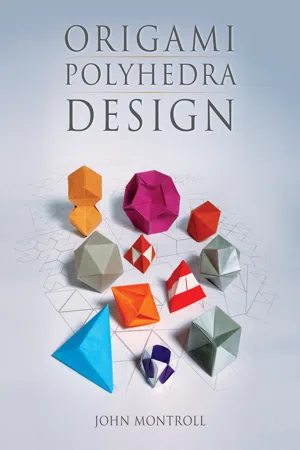eBook - PDF
Origami Polyhedra Design
About this book
This book unravels the mystery of Geometry in Origami with a unique approach: 64 Polyhedra designs, each made from a single square sheet of paper, no cuts, no glue; each polyhedron the largest possible from the starting size of square and each having an ingenious locking mechanism to hold its shape. The author covers the five Platonic solids (cube,
Frequently asked questions
Yes, you can cancel anytime from the Subscription tab in your account settings on the Perlego website. Your subscription will stay active until the end of your current billing period. Learn how to cancel your subscription.
At the moment all of our mobile-responsive ePub books are available to download via the app. Most of our PDFs are also available to download and we're working on making the final remaining ones downloadable now. Learn more here.
Perlego offers two plans: Essential and Complete
- Essential is ideal for learners and professionals who enjoy exploring a wide range of subjects. Access the Essential Library with 800,000+ trusted titles and best-sellers across business, personal growth, and the humanities. Includes unlimited reading time and Standard Read Aloud voice.
- Complete: Perfect for advanced learners and researchers needing full, unrestricted access. Unlock 1.4M+ books across hundreds of subjects, including academic and specialized titles. The Complete Plan also includes advanced features like Premium Read Aloud and Research Assistant.
We are an online textbook subscription service, where you can get access to an entire online library for less than the price of a single book per month. With over 1 million books across 1000+ topics, we’ve got you covered! Learn more here.
Look out for the read-aloud symbol on your next book to see if you can listen to it. The read-aloud tool reads text aloud for you, highlighting the text as it is being read. You can pause it, speed it up and slow it down. Learn more here.
Yes! You can use the Perlego app on both iOS or Android devices to read anytime, anywhere — even offline. Perfect for commutes or when you’re on the go.
Please note we cannot support devices running on iOS 13 and Android 7 or earlier. Learn more about using the app.
Please note we cannot support devices running on iOS 13 and Android 7 or earlier. Learn more about using the app.
Yes, you can access Origami Polyhedra Design by John Montroll in PDF and/or ePUB format, as well as other popular books in Mathematik & Spiele in der Mathematik. We have over one million books available in our catalogue for you to explore.
Information

Designing
Origami
Polyhedra
Part
I


3
Polyhedra
Overview
Polyhedra
are
three-dimensional
shapes
composed
of
polygons,
two-dimensional
shapes
composed
of
straight
lines.
Here
we
present
some
of
the
names
associated
with
polyhedra.
Concave
Polyhedra
If
there
are
any
lines
connecting
two
points
on
the
surface
that
are
outside
the
polyhedron
(as
in
the
first
picture
below),
even
partially,
then
the
polyhedron
is
concave,
or
nonconvex.
Sunken
Cube
(Sunk)
Platonic
Solids
A
Platonic
solid
is
a
convex
polyhedron
composed
of
identical
regular
polygons
with
identical
vertices.
Thus,
all
of
the
edges
are
the
same
length,
the
same
number
of
edges
meet
at
each
vertex,
and
all
the
faces
are
the
same
shape.
There
are
five
Platonic
solids:
the
tetrahedron,
cube,
octahedron,
icosahedron,
and
dodecahedron.
Tetrahedron
Cubehemioctahedron
(Dimpled)
Stellated
Cube
(Star)
Convex
Polyhedra
Take
any
two
points
on
the
surface
of
a
polyhedron
and
picture
a
line
connecting
them
(as
in
the
first
picture
below).
A
polyhedron
is
convex
if
all
such
lines
are
either
on
the
surface
of
the
polyhedron
or
are
completely
inside
the
polyhedron.
Icosahedron
Cube
Octahedron
Icosahedron
Dodecahedron
Hexagonal
Dipyramid
Pentagonal
Pyramid
Table of contents
- Front Cover
- Table of Contents
- Symbols
- Basic Folds
- Introduction
- Part I
- Part II
- Part III
- Back Cover
